| Listing 1 - 10 of 11 | << page >> |
Sort by
|
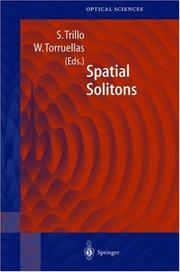
ISBN: 3540416536 3642074987 354044582X Year: 2001 Volume: 82 Publisher: Berlin ; New York : Springer,
Abstract | Keywords | Export | Availability | Bookmark
 Loading...
Loading...Choose an application
- Reference Manager
- EndNote
- RefWorks (Direct export to RefWorks)
Soliton-based concepts open the road for newly designed laser sources, new frequency converters and high-intensity laser-material interactions. Optical solitons as stable spatial patterns of complex nonlinear systems allow for the control of the diffraction of optical beams. Solitons also prevent unwanted chaotic behavior. Thus, solitary wave physics plays a significant role from modern optical physics to optical communication, optical switching, and optical storage. The book gives an updated overview of optical solitons and can serve as a reference and guide for advanced students and scientists working in the field and related areas of science where solitons are observed.
Solitons --- Solitons. --- Lasers. --- Photonics. --- Quantum optics. --- Optics, Lasers, Photonics, Optical Devices. --- Quantum Optics. --- Optics --- Photons --- Quantum theory --- New optics --- Light amplification by stimulated emission of radiation --- Masers, Optical --- Optical masers --- Light amplifiers --- Light sources --- Optoelectronic devices --- Nonlinear optics --- Optical parametric oscillators
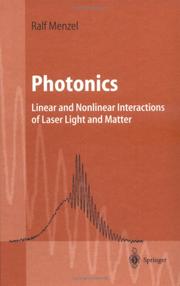
ISBN: 3540670742 3662045230 3662045214 9783540670742 Year: 2001 Publisher: Berlin: Springer,
Abstract | Keywords | Export | Availability | Bookmark
 Loading...
Loading...Choose an application
- Reference Manager
- EndNote
- RefWorks (Direct export to RefWorks)
This book covers the fundamental properties and the description of single photons and light beams, experimentally and theoretically. It explains the essentials of linear interactions and most nonlinear interactions between light and matter in both the transparent and absorbing cases. It also provides a basic understanding of modern lasers, as well as the principles of nonlinear optical spectroscopy. It is self-consistent and enriched by a large number of calculated illustrations, examples, and descriptive tables. Graduate students in physics and electrical engineering, as well as other sciences, will find this book a thorough introduction to the field, while for lecturers and scientists it is a rich source of useful information and a ready-to-hand reference.
Optics. Quantum optics --- Photonics --- Photonique --- Photonics. --- Lasers. --- Physical chemistry. --- Laboratory medicine. --- Electrical engineering. --- Quantum optics. --- Optics, Lasers, Photonics, Optical Devices. --- Physical Chemistry. --- Laboratory Medicine. --- Electrical Engineering. --- Quantum Optics. --- New optics --- Optics --- Photons --- Quantum theory --- Electric engineering --- Engineering --- Clinical medicine --- Clinical pathology --- Diagnostic laboratory tests --- Laboratory diagnosis --- Laboratory medicine --- Medical laboratory diagnosis --- Diagnosis --- Pathology --- Chemistry, Theoretical --- Physical chemistry --- Theoretical chemistry --- Chemistry --- Light amplification by stimulated emission of radiation --- Masers, Optical --- Optical masers --- Light amplifiers --- Light sources --- Optoelectronic devices --- Nonlinear optics --- Optical parametric oscillators
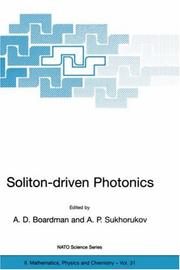
ISBN: 9401006822 0792371313 0792371305 Year: 2001 Volume: v. 31 Publisher: Dordrecht ; Boston ; London Brussels Kluwer Academic Publishers NATO Scientific Affairs Division
Abstract | Keywords | Export | Availability | Bookmark
 Loading...
Loading...Choose an application
- Reference Manager
- EndNote
- RefWorks (Direct export to RefWorks)
It is ironic that the ideas ofNewton, which described a beam of light as a stream ofparticles made it difficult for him to explain things like thin film interference. Yet these particles, called 'photons', have caused the adjective 'photonic' to gain common usage, when referring to optical phenomena. The purist might argue that only when we are confronted by the particle nature of light should we use the word photonics. Equally, the argument goes on, only when we are face-to face with an integrable system, i. e. one that possesses an infinite number of conserved quantities, should we say soliton rather than solitary wave. Scientists and engineers are pragmatic, however, and they are happy to use the word 'soliton' to describe what appears to be an excitation that is humped, multi humped, or localised long enough for some use to be made of it. The fact that such 'solitons' may stick to each other (fuse) upon collision is often something to celebrate for an application, rather than just evidence that, after all, these are not really solitons, in the classic sense. 'Soliton', therefore, is a widely used term with the qualification that we are constantly looking out for deviant behaviour that draws our attention to its solitary wave character. In the same spirit, 'photonics' is a useful generic cover-all noun, even when 'electromagnetic theory' or 'optics' would suffice.
Photonics --- Solitons --- Physics --- Engineering & Applied Sciences --- Physical Sciences & Mathematics --- Applied Physics --- Light & Optics --- Photonics. --- Solitons. --- Photonique --- Optics. --- Electrodynamics. --- Lasers. --- Materials science. --- Mathematical physics. --- Classical Electrodynamics. --- Optics, Lasers, Photonics, Optical Devices. --- Characterization and Evaluation of Materials. --- Theoretical, Mathematical and Computational Physics. --- Physical mathematics --- Material science --- Physical sciences --- New optics --- Optics --- Light amplification by stimulated emission of radiation --- Masers, Optical --- Optical masers --- Light amplifiers --- Light sources --- Optoelectronic devices --- Nonlinear optics --- Optical parametric oscillators --- Dynamics --- Light --- Mathematics
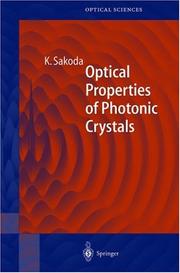
ISBN: 3540411992 3662143267 3662143240 9783540411994 Year: 2001 Volume: 80 Publisher: Berlin : Springer,
Abstract | Keywords | Export | Availability | Bookmark
 Loading...
Loading...Choose an application
- Reference Manager
- EndNote
- RefWorks (Direct export to RefWorks)
The interaction between the radiation field and matter is the most fundamen tal source of dynamics in nature. It brings about the absorption and emission of photons, elastic and inelastic light scattering, the radiative lifetime of elec tronic excited states, and so on. The huge amount of energy carried from the sun by photons is the source of all activities of creatures on the earth. The absorption of photons by chlorophylls and the successive electronic excita tion initiate a series of chemical reactions that are known as photosynthesis, which support all life on the earth. Radiative energy is also the main source of all meteorological phenomena. The fundamentals of the radiation field and its interaction with matter were clarified by classical electromagnetism and quantum electrodynamics. These theories, we believe, explain all electromagnetic phenomena. They not only provide a firm basis for contemporary physics but also generate a vast range of technological applications. These include television, radar, optical and microwave telecommunications, lasers, light-emitting diodes, solar cells, etc. Now, the interaction between the radiation field and matter is so funda mental that it may seem universal and invariant. But in fact it is controllable.
Crystal optics --- Photons --- 681.7.036 --- Crystals --- Optical crystallography --- Crystallography --- Physical optics --- Light quantum --- Light --- Einstein-Podolsky-Rosen experiment --- Optical apparatus and instruments--?.036 --- Optical properties --- Crystal optics. --- Photons. --- 681.7.036 Optical apparatus and instruments--?.036 --- Lasers. --- Photonics. --- Crystallography. --- Optics, Lasers, Photonics, Optical Devices. --- Crystallography and Scattering Methods. --- Leptology --- Physical sciences --- Mineralogy --- New optics --- Optics --- Light amplification by stimulated emission of radiation --- Masers, Optical --- Optical masers --- Light amplifiers --- Light sources --- Optoelectronic devices --- Nonlinear optics --- Optical parametric oscillators
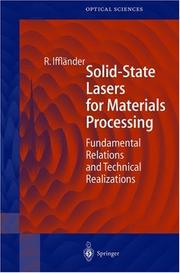
ISBN: 3540669809 3642086306 3540465855 Year: 2001 Publisher: Berlin : Springer,
Abstract | Keywords | Export | Availability | Bookmark
 Loading...
Loading...Choose an application
- Reference Manager
- EndNote
- RefWorks (Direct export to RefWorks)
This book explains in detail the technical and physical basic principles of solid-state lasers for material processing. The characteristic parameters of laser beams, such as beam quality, power and efficiency, are related to parameters of practical use. Conventional applications of high power lasers, such as laser welding, cutting and scribing, as well as the basics of laser-matter interactions, are also discussed in the book. The types of lasers considered include: high power Nd, Yb:YAG, Nd-glass lamp- or laserdiode-pumped. Data on potential materials for solid-state lasers such as alexandrite, GGG, YVO, YLF and others are presented. Aspectys of laser device design, for example, beam optics and beam guiding by fiber, are discussed. Many tables and graphics make this a useful handbook for scientists, process engineers, laser physicists and advanced students.
Optics. Quantum optics --- Solid state physics --- Solid-state lasers. --- Optics. --- Electrodynamics. --- Lasers. --- Photonics. --- Physical measurements. --- Measurement . --- Engineering. --- Materials science. --- Classical Electrodynamics. --- Optics, Lasers, Photonics, Optical Devices. --- Measurement Science and Instrumentation. --- Engineering, general. --- Characterization and Evaluation of Materials. --- Material science --- Physical sciences --- Construction --- Industrial arts --- Technology --- Measuring --- Mensuration --- Mathematics --- Metrology --- Physical measurements --- Measurements, Physical --- Mathematical physics --- Measurement --- New optics --- Optics --- Light amplification by stimulated emission of radiation --- Masers, Optical --- Optical masers --- Light amplifiers --- Light sources --- Optoelectronic devices --- Nonlinear optics --- Optical parametric oscillators --- Dynamics --- Physics --- Light
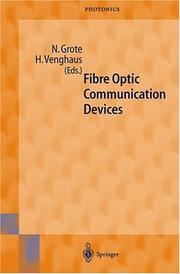
ISBN: 3540669779 364263124X 3642564666 Year: 2001 Volume: 4 Publisher: Berlin ; New York : Springer,
Abstract | Keywords | Export | Availability | Bookmark
 Loading...
Loading...Choose an application
- Reference Manager
- EndNote
- RefWorks (Direct export to RefWorks)
The book covers all essential elements of current and next generation fibre optic networks, including many that are ignored in other books. The reader gains an in-depth understanding of the current and future capabilities of fibre optic communication networks. He can estimate what fibre optics has to provide and where its (current and long-term) limitations may lie. Optoelectronic devices and glass fibres are the basis of contemporary communication systems. The book deals with the various components of these systems such as lasers, amplifiers, modulation devices, converters, optical switches, filters, detectors, emitters, sensors and fibre transfer systems. A systematic evaluation of the state of the art in related technological research and the level reached in application is given.
Optical communications --- Optoelectronic devices --- Dispositifs optoélectroniques --- Equipment and supplies --- Goeiders --- Optische vezel telecommunicatie --- Goeiders. --- Optische vezel telecommunicatie. --- Dispositifs optoélectroniques --- Lasers. --- Photonics. --- Electrical engineering. --- Optical materials. --- Electronic materials. --- Computer hardware. --- Electronics. --- Microelectronics. --- Optics, Lasers, Photonics, Optical Devices. --- Communications Engineering, Networks. --- Optical and Electronic Materials. --- Computer Hardware. --- Electronics and Microelectronics, Instrumentation. --- Microminiature electronic equipment --- Microminiaturization (Electronics) --- Electronics --- Microtechnology --- Semiconductors --- Miniature electronic equipment --- Electrical engineering --- Physical sciences --- Electronic materials --- Optics --- Materials --- Electric engineering --- Engineering --- New optics --- Light amplification by stimulated emission of radiation --- Masers, Optical --- Optical masers --- Light amplifiers --- Light sources --- Nonlinear optics --- Optical parametric oscillators
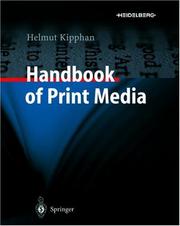
ISBN: 3540673261 3642631428 3540299009 3540335706 Year: 2001 Publisher: Berlijn Springer
Abstract | Keywords | Export | Availability | Bookmark
 Loading...
Loading...Choose an application
- Reference Manager
- EndNote
- RefWorks (Direct export to RefWorks)
This handbook is a comprehensive guide to both the traditional and new, digital technologies involved in all phases of print media production. Electronic media and multimedia are also explained and positioned. The technologies and production systems covered are state-of-the-art and represent a multitude of products from well-known manufacturers worldwide. The relative positions the printing processes occupy are given on the basis of performance features and the market sectors of print media, while trends for print media production are also high-lighted. As a detailed reference and also standard work, this book is the ideal companion for technically and commercially oriented specialists and management in the graphic arts industry. As for printshops, prepress and postpress operations, publishing houses, the supporting industry and trade associations, this book is also invaluable for experts working on research projects, lecturers, trainees and students at training centers, colleges, polytechs and universities. The content of the Handbook is based on the German edition, translated in cooperation with an international team of translators with experience in publishing and graphic arts subjects. The easy to find, reliable information supports and complements the skills of the professional in the field, while offering management orientation in reaching strategic and investment decisions and providing students with a sound basis of usable knowledge. The detailed, colored layout and the many pictures, graphics and tables support this easy to use structure. The robust design of the Handbook ensures a long service life, even with daily use. The accompanying CD-ROM enables the reader to perform a full text search within the entire book, and guides him through the comprehensive texts and pictures.
Printing industry --- Printing machinery and supplies --- Printing --- Technological innovations --- Graphics industry --- druktechnieken --- Journalism --- Grafische industrie --- Grafische productieproces --- 686.2 --- 684 --- grafische industrie --- multimedia --- prepress --- 338.755.2 --- AA / International- internationaal --- verwerkende industrie, grafische techniek --- Drukkerij en uitgeverij --- Paper converting machinery --- Manufacturing industries --- Machinery. --- Multimedia systems . --- Manufactures. --- Lasers. --- Photonics. --- Machinery and Machine Elements. --- Media Design. --- Manufacturing, Machines, Tools, Processes. --- Optics, Lasers, Photonics, Optical Devices. --- New optics --- Optics --- Light amplification by stimulated emission of radiation --- Masers, Optical --- Optical masers --- Light amplifiers --- Light sources --- Optoelectronic devices --- Nonlinear optics --- Optical parametric oscillators --- Manufactured goods --- Manufactured products --- Products --- Products, Manufactured --- Commercial products --- Computer-based multimedia information systems --- Multimedia computing --- Multimedia information systems --- Multimedia knowledge systems --- Information storage and retrieval systems --- Machinery --- Machines --- Manufactures --- Power (Mechanics) --- Technology --- Mechanical engineering --- Motors --- Power transmission --- Curious devices --- Grafische sector --- Industrie --- Geschiedenis --- Prognose --- Statistische gegevens --- Atlas --- Museum --- Voorlichting --- Reclame --- Spionage --- Communicatietheorie
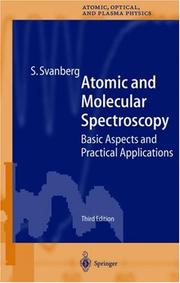
ISBN: 3540674322 354055243X 038755243X 3642973981 3642981097 3642981070 9783540552437 9783540674320 Year: 2001 Volume: 6 Publisher: Berlin: Springer,
Abstract | Keywords | Export | Availability | Bookmark
 Loading...
Loading...Choose an application
- Reference Manager
- EndNote
- RefWorks (Direct export to RefWorks)
Atomic and Molecular Spectroscopy is a wide-ranging review of modern spectroscopic techniques such as X-ray, photoelectron, optical and laser spectroscopy, as well as radiofrequency and microwave techniques. On the fundamental side, it focuses on physical principles and the impact of spectroscopy on our understanding of the building blocks of matter, while in the area of applications particular attention is paid to chemical analysis, photochemistry, surface characterisation, environmental and medical diagnostics, remote sensing and astrophysics. The third edition also provides the reader with an update on laser cooling and trapping, Bose-Einstein condensation, ultrafast spectroscopy, high-power laser/matter interaction, satellite-based astronomy and spectroscopic aspects of laser medicine.
Molecular spectroscopy --- Atomic spectroscopy. --- Molecular spectroscopy. --- Spectroscopie moléculaire --- Spectroscopie moléculaire --- Atomic spectroscopy --- #ABIB:adid --- Spectroscopy, Molecular --- Spectrum analysis --- Molecular spectra --- Spectroscopy, Atomic --- Spectroscopie atomique --- RADIATIONS --- LASERS --- PROCESSES --- Optical spectroscopy --- ATOMIC STRUCTURE --- SCATTERING --- MOLECULAR STRUCTURE --- Monograph --- Lasers. --- Atomic structure. --- Molecular structure. --- Structure, Molecular --- Chemical structure --- Structural bioinformatics --- Structure, Atomic --- Atomic theory --- Spectroscopy, Optical --- Visible spectroscopy --- Light amplification by stimulated emission of radiation --- Masers, Optical --- Optical masers --- Light amplifiers --- Light sources --- Optoelectronic devices --- Nonlinear optics --- Optical parametric oscillators --- Atoms. --- Physics. --- Photonics. --- Physical chemistry. --- Geotechnical engineering. --- Mineralogy. --- Atomic, Molecular, Optical and Plasma Physics. --- Optics, Lasers, Photonics, Optical Devices. --- Physical Chemistry. --- Geotechnical Engineering & Applied Earth Sciences. --- Chemistry, Theoretical --- Physical chemistry --- Theoretical chemistry --- Chemistry --- Physical geology --- Crystallography --- Minerals --- Engineering, Geotechnical --- Geotechnics --- Geotechnology --- Engineering geology --- New optics --- Optics --- Natural philosophy --- Philosophy, Natural --- Physical sciences --- Dynamics --- Chemistry, Physical and theoretical --- Matter --- Stereochemistry --- Constitution
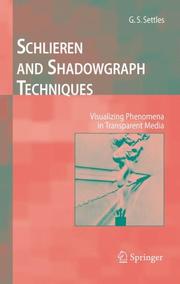
ISBN: 9783540661559 3540661557 3642630340 3642566405 Year: 2001 Publisher: Berlin : Springer,
Abstract | Keywords | Export | Availability | Bookmark
 Loading...
Loading...Choose an application
- Reference Manager
- EndNote
- RefWorks (Direct export to RefWorks)
Schlieren and shadowgraph techniques are basic and valuable tools in various scientific and engineering disciplines. They allow us to see the invisible: the optical inhomogeneities in transparent media like air, water, and glass that otherwise cause only ghostly distortions of our normal vision. These techniques are discussed briefly in many books and papers, but there is no up-to-date complete treatment of the subject before now. The book is intended as a practical guide for those who want to use these methods, as well as a resource for a broad range of disciplines where scientific visualization is important. The colorful 400-year history of these methods is covered in an extensive introductory chapter accessible to all readers.
543.4 --- 532 --- 532 Fluid mechanics in general. Mechanics of liquids (hydromechanics) --- Fluid mechanics in general. Mechanics of liquids (hydromechanics) --- 543.4 Optical methods of analysis --- Optical methods of analysis --- radiometrische analyse --- fotometrie --- Schlieren methods (Optics) --- Photography, Shadowgraph --- Photography, Shadowgraph. --- Schlieren methods (Optics). --- Optics. Quantum optics --- optica --- Fluid mechanics. --- Fluids. --- Engineering. --- Lasers. --- Photonics. --- Thermodynamics. --- Chemical engineering. --- Engineering Fluid Dynamics. --- Fluid- and Aerodynamics. --- Engineering, general. --- Optics, Lasers, Photonics, Optical Devices. --- Industrial Chemistry/Chemical Engineering. --- Chemistry, Industrial --- Engineering, Chemical --- Industrial chemistry --- Engineering --- Chemistry, Technical --- Metallurgy --- Chemistry, Physical and theoretical --- Dynamics --- Mechanics --- Physics --- Heat --- Heat-engines --- Quantum theory --- New optics --- Optics --- Light amplification by stimulated emission of radiation --- Masers, Optical --- Optical masers --- Light amplifiers --- Light sources --- Optoelectronic devices --- Nonlinear optics --- Optical parametric oscillators --- Construction --- Industrial arts --- Technology --- Hydraulics --- Hydrostatics --- Permeability --- Hydromechanics --- Continuum mechanics
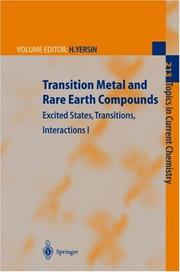
ISBN: 3540679863 5540679766 3540679766 3540444475 3540444742 9783540679868 9783540679769 Year: 2001 Volume: 213-214 Publisher: Berlin: Springer,
Abstract | Keywords | Export | Availability | Bookmark
 Loading...
Loading...Choose an application
- Reference Manager
- EndNote
- RefWorks (Direct export to RefWorks)
There exists a large literature on the spectroscopic properties of copper(II) com- 9 pounds. This is due to the simplicity of the d electron configuration, the wide variety of stereochemistries that copper(II) compounds can adopt, and the f- xional geometric behavior that they sometimes exhibit [1]. The electronic and geometric properties of a molecule are inexorably linked and this is especially true with six-coordinate copper(II) compounds which are subject to a Jahn-T- ler effect.However,the spectral-structural correlations that are sometimes d- wn must often be viewed with caution as the information contained in a typical solution UV-Vis absorption spectrum of a copper(II) compound is limited. Meaningful spectral-structural correlations can be obtained in a related series of compounds where detailed spectroscopic data is available. In the fol- 4– lowing sections two such series are examined; the six-coordinate CuF and 6 2+ Cu(H O) ions doped as impurities in single crystal hosts.Using low tempera- 2 6 ture polarized optical spectroscopy and electron paramagnetic resonance, a very detailed picture can be drawn about the geometry of these ions in both their ground and excited electronic states. We then compare the spectrosco- cally determined structural data with that obtained from X-ray diffraction or EXAFS measurements.
Transition metal compounds. --- Rare earth metal compounds. --- Excited state chemistry. --- Métaux de transition --- Métaux des terres rares --- Chimie des états excités --- Composés --- Metaux de transition --- Metaux des terres rares --- Chimie des etats excites. --- Spectroscopie de luminescence. --- Chimie des etats excites --- Composes. --- Chemistry. --- Inorganic chemistry. --- Organic chemistry. --- Physical chemistry. --- Optics. --- Optoelectronics. --- Plasmons (Physics). --- Inorganic Chemistry. --- Organic Chemistry. --- Physical Chemistry. --- Optics, Optoelectronics, Plasmonics and Optical Devices. --- 546.65 --- 661.865 --- #WSCH:AAS2 --- Rare earths in general --- Rare earth compounds in general --- 661.865 Rare earth compounds in general --- 546.65 Rare earths in general --- Physical organic chemistry. --- Chemistry, Inorganic. --- Spectrum analysis. --- Métaux de transition --- Métaux des terres rares --- Chimie des états excités --- Composés --- Lasers. --- Photonics. --- Optics, Lasers, Photonics, Optical Devices. --- New optics --- Optics --- Light amplification by stimulated emission of radiation --- Masers, Optical --- Optical masers --- Light amplifiers --- Light sources --- Optoelectronic devices --- Nonlinear optics --- Optical parametric oscillators --- Chemistry, Theoretical --- Physical chemistry --- Theoretical chemistry --- Chemistry --- Organic chemistry --- Inorganic chemistry --- Inorganic compounds --- Metaux de transition - Composes. --- Metaux des terres rares - Composes. --- Rare earth compounds --- Transition metal compounds
| Listing 1 - 10 of 11 | << page >> |
Sort by
|

 Search
Search Feedback
Feedback About UniCat
About UniCat  Help
Help News
News